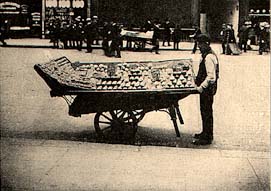
Little Drummond Street in 1827
John Cein appears to have a been a callous individual, however you look at it. Cein was a tailor who worked for a Mr Cave on Argyle Street (near the Gray’s Inn Road). He had a wife and four children.
However at some point in 1860 Cein left his wife and moved out. As a consequence the family fell on hard times and Mrs Cein was unable to support them. By the end of October she had already buried one child and another lay dead. She had recently gone to the parish to ask for help and so had been directed to the workhouse, the ultimate disgrace for the poor in the Victorian period.
Now the parish officials went in pursuit of John and he was tracked down to a house at 13 Little Drummond Street by the gate porter at the St. Giles workhouse. The porter, Richard Dyer, found Cein in bed with another woman and arrested him.
The tailor was brought before Mr Tyrwhitt at Marlborough Street Police Court and charged with ‘deserting his wife and leaving her and his four children chargeable on the parish of St. James’. Dyer said that when he took Cein into custody the other woman removed a watch and chain from his neck ‘and said she would come to court and settle for him in the morning’. However, there was no sign of her at Marlborough Street.
John Cein claimed he had already attempted to discharge his responsibilities towards his wife by offering the parish 5s a week to care for them, but this had been refused. The magistrate warned him that if he could not come to some arrangement he would send him to prison for a month, and keep repeating the sentence until he did settle.
Cein and a parish officer briefly left the courtroom to negotiate but were soon back, having not been able to agree a fee to maintain Mrs Cein. Mr Tyrwhitt made good on his threat and sent to tailor to gaol. A ‘pale careworn-looking’ Mrs Cein was in court to hear all of this and voiced her distress telling the ‘beak’ that it was ‘through want and the prisoner’s cruelty that her children were dead’.
I’m sure John Cein was a callous man and in abandoning his wife and children he condemned them to poverty and perhaps even caused the death of the infants. But I can’t see how sending him to prison really helped Mrs Cein and her surviving children. The parish acted not our of concern for her or them, but to indemnify themselves (and the better off ratepayers) from having to support them on the Poor Rates. The Victorian system (especially after the 1834 Poor Law Amendment Act) was institutionally cruel and condemned tens of thousands to a hand-bu-mouth existence riven by disease, desperation and death.
[from The Morning Post, Sunday, October 31, 1860]



